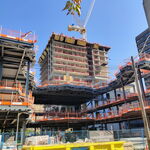A joint task force report between the city and province – which government has been sitting on for nearly two years – recommends adding 12 to 20 new electric buses to Winnipeg Transit’s fleet as the next step in electrifying the city’s bus service.
The report, obtained by the Winnipeg Sun, says adding 12 new electric buses to the fleet would cost taxpayers about $1.9 million more than purchasing the same number of diesel buses – including operational savings – if they were added to “peak-use” routes during rush hour periods.
The cost gap could be greater in “high-use” routes – where buses are used for longer periods of time and often switch routes – largely because of greater charging station requirements, the report said.
But as electric bus technology continues to improve, including the rapid development of en-route battery charging equipment, the price gap between diesel and electric buses continues to narrow, the task force found.
“Electric buses are essentially at the cusp of readiness,” the report says. “Their already lower operating costs (fuel and maintenance), combined with anticipated future capital cost reductions, suggests the longer-term advantage is toward electric buses.”
The report, entitled The Future is Ahead of You: Battery-Electric Bus Zero Emissions, was completed in July 2016. That was several months after the Pallister government took office and about eight months after former premier Greg Selinger and Mayor Brian Bowman announced the creation of the task force. But for reasons that remain unclear, the report was never released publicly.
The task force, made up of representatives from six stakeholder groups including the city, the province, Manitoba Hydro, New Flyer Industries and Red River College, not only confirmed electric bus technology works effectively in sometimes harsh climates like Winnipeg’s, it laid out a three-step plan on how to integrate battery-powered buses into Transit’s fleet.
One of the main findings of the report is that electric bus technology is not itself a barrier to fully electrifying Transit. The challenge is how to integrate electric buses into a transit system designed around diesel buses, the task force found.
Diesel buses can travel up to 22 hours a day and are used whenever and wherever they’re needed, with easy refueling. And they can switch seamlessly between routes at any time to help keep scheduling on time. Electric buses, which need to be recharged, aren’t as flexible. New battery-powered buses have a range of about 325 kilometers, which is expected to grow to about 500 kilometers by 2019, according to New Flyer Industries which built the four electric buses still in use in Winnipeg. But they still need to be recharged at some point. Which means there’s more planning involved than there is for diesel buses, including where and how many recharging stations are required.
“This feature is a cornerstone of existing transit system planning and operation, and must be assessed in greater detail to better understand the implications of using electric buses, with different operating characteristics,” the report says. “This important finding has not been previously identified as an issue for electric buses.”
But it’s not an insurmountable challenge, either, the task force says. What it underscores is the need to integrate electric buses into the system gradually, beginning with 12 to 20 buses , about 2% to 3% of Winnipeg Transit’s fleet, “to deploy a sufficient number of buses to confirm they can operate in the real world at a large scale.”
A second phase would add another 120 to 200 buses, about 25% to 30% of the fleet. And a third phase would see the entire fleet, or close to the entire fleet, electrified, the task force recommends.
“The biggest hurdle is not the electric technology in individual buses,” the report says. “Rather, it is the challenge of how to transform an old system, designed around diesel, to a new system of planning, operation and maintenance, based on new electric bus and charging technologies.”
Electric buses also have far less maintenance than diesel buses, in part because they don’t have transmissions or complicated emissions control systems which require frequent servicing. And because they have zero emissions, they can reduce greenhouse gases between 57 and 113 tonnes a year per bus compared to diesel.
After several years of testing four electric buses in Winnipeg, the city is well-positioned to take the next step in bus electrification, the task force concluded. Now we just need the political will.

















